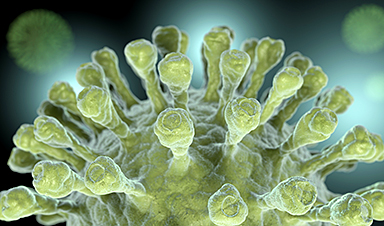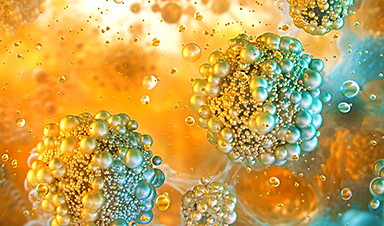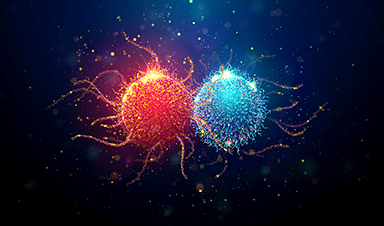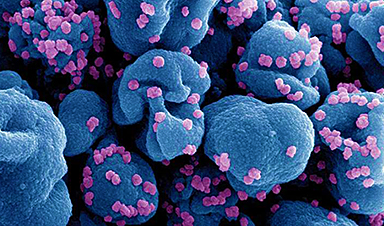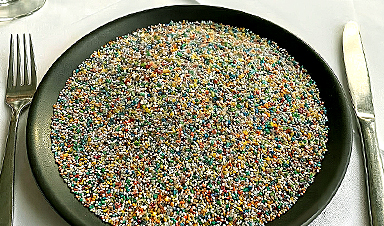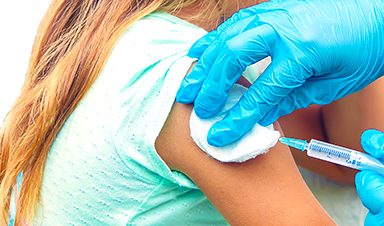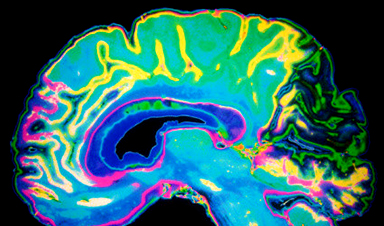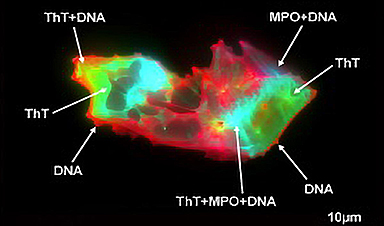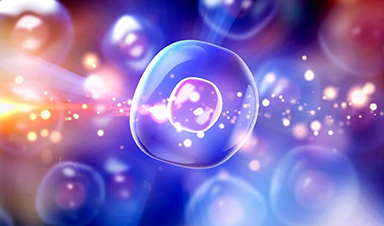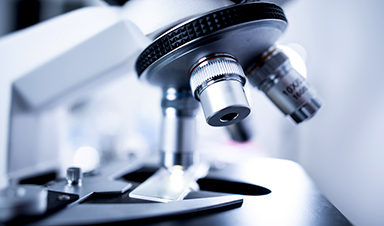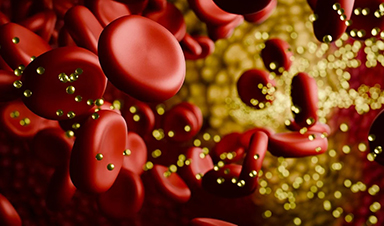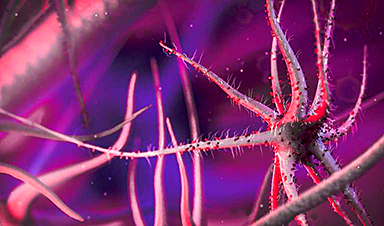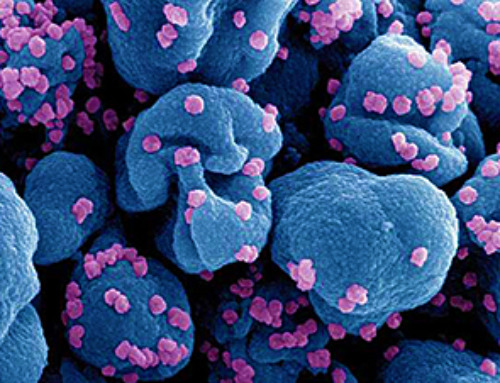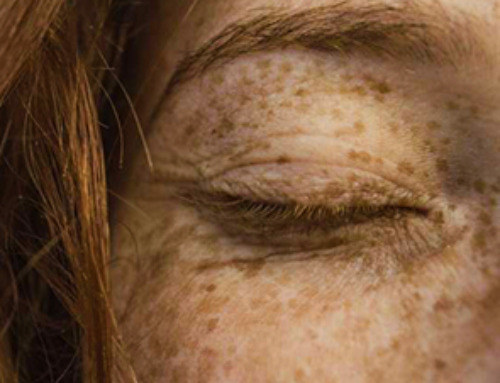A coronavirus uses protein “spikes” to grab and infect cells. Despite their name, those spikes aren’t stiff and pointy. They’re shaped like chicken drumsticks with the meaty part facing out, and the meaty part can tilt every which way on its slender stalk. That ability to tilt, it turns out, affects how successfully the spike can infect a cell.
While the study was carried out on a much less dangerous cousin of SARS-CoV-2, the coronavirus that causes COVID-19, it has implications for COVID-19, too, since both viruses bind to the same receptor on a cell’s surface to initiate infection, said Jing Jin, a biologist at Vitalant Research Institute and adjunct assistant professor at the University of California, San Francisco who performed virology experiments for the study.
The results, she said, suggest that disabling the spike’s hinges could be a good way to prevent or treat a wide range of coronavirus infections.
The team also discovered that each coronavirus particle is unique, both in its underlying shape and its display of spikes. Some are spherical, some are not; some bristle with spikes while others are nearly bald.
“The spikes are floppy and move around, and we used a combination of tools to explore all their possible angles and orientations,” said Greg Pintilie, a Stanford scientist who developed detailed 3D models of the virus and its spikes. Seen up close, he said, each spike is different from all the rest, mainly in its direction and degree of tilting.
The research team reported its findings in Nature Communications.
“Since the pandemic started, most studies have looked at the structures of coronavirus spike proteins that were not attached to the virus itself,” said Wah Chiu, a professor at SLAC and Stanford and co-director of the Stanford-SLAC Cryo-EM facilities where the imaging was done. “These are the first images made of the spikes of this strain of coronavirus while they’re still attached to the virus particles.”
SARS-CoV-2’s more benign cousin
The study has roots in the early days of the pandemic, when research at SLAC shut down except for work aimed at understanding, preventing and treating COVID-19 infections.
Because experiments with the actual SARS-CoV-2 virus can only take place in high-level (BSL3) biosafety labs, many scientists chose to work with more benign members of the coronavirus family. Chiu and his colleagues selected human coronavirus NL63 as their subject. It causes up to 10% of human respiratory infections, mainly in children and immunocompromised people, with symptoms ranging from mild coughs and sniffles to bronchitis and croup.
In 2020, Chiu said, the team used cryogenic electron microscopy (cryo-EM) and computational analysis to image the crowns of NL63 spikes with near-atomic resolution.
But because a spike’s stalk is much thinner than its crown, they were not able to get clear, high-resolution images of both at once.
Zooming in on spikes
This study combined information gleaned from a series of experiments to get a much more complete picture.
First, Stanford graduate student David Chmielewski used cryogenic electron tomography (cryo-ET) to combine cryo-EM images of viruses that were taken from different angles into high-resolution 3D images of more than a hundred NL63 particles.
SLAC senior scientist Michael Schmid plugged those images into a 3D visualization tool and discovered that each of a particle’s spikes was bent in a unique way. Another SLAC scientist, Muyuan Chen, used advanced image reconstruction to create maps showing the average density of the spikes’ crowns and stalks.
Zooming in on one of those spikes, biological chemist Lance Wells at the University of Georgia used a technique called mass spectrometry to pinpoint the site-specific chemical compositions of the 39 sugar chains attached to each of the spike’s three identical proteins.
Finally, Abhishek Singharoy, a computational biophysicist at Arizona State University, and his student, Eric Wilson, integrated all those measurements into atomic models of the spikes’ crowns and stalks at different bending angles, and carried out further simulations to see how far and how freely a spike can bend.
“It turns out that no matter what, the spikes have a preferred bending angle of about 50 degrees,” Chiu said, “and they can tilt up to 80 degrees in any direction in the simulation, which matches well with our cryo-ET experimental observations.”
The bending occurred at a place on the stalk, just below the crown, where a particular cluster of sugar molecules clung to the protein, forming a hinge. Computer simulations suggested that changes in the structure of this hinge would affect its ability to bend, and lab experiments went one step further: They showed that mutations in the protein part of the hinge made the spike much less infectious. This suggests that targeting the hinge could provide an avenue to fight the virus.
“People working on the more dangerous coronaviruses, including MERS-CoV and SARS-CoV-2, have identified a region equivalent to this one and discovered antibodies targeting this region,” Jin said. “That tells us it’s a critical region that is highly conserved, meaning that it has stayed much the same over the course of evolution. So maybe by targeting this region in all coronaviruses, we can come up with a universal therapy or vaccine.”
More information: David Chmielewski et al, Structural insights into the modulation of coronavirus spike tilting and infectivity by hinge glycans, Nature Communications (2023). DOI: 10.1038/s41467-023-42836-9
News
Platelet-inspired nanoparticles could improve treatment of inflammatory diseases
Scientists have developed platelet-inspired nanoparticles that deliver anti-inflammatory drugs directly to brain-computer interface implants, doubling their effectiveness. Scientists have found a way to improve the performance of brain-computer interface (BCI) electrodes by delivering anti-inflammatory drugs directly [...]
After 150 years, a new chapter in cancer therapy is finally beginning
For decades, researchers have been looking for ways to destroy cancer cells in a targeted manner without further weakening the body. But for many patients whose immune system is severely impaired by chemotherapy or radiation, [...]
Older chemical libraries show promise for fighting resistant strains of COVID-19 virus
SARS‑CoV‑2, the virus that causes COVID-19, continues to mutate, with some newer strains becoming less responsive to current antiviral treatments like Paxlovid. Now, University of California San Diego scientists and an international team of [...]
Lower doses of immunotherapy for skin cancer give better results, study suggests
According to a new study, lower doses of approved immunotherapy for malignant melanoma can give better results against tumors, while reducing side effects. This is reported by researchers at Karolinska Institutet in the Journal of the National [...]
Researchers highlight five pathways through which microplastics can harm the brain
Microplastics could be fueling neurodegenerative diseases like Alzheimer's and Parkinson's, with a new study highlighting five ways microplastics can trigger inflammation and damage in the brain. More than 57 million people live with dementia, [...]
Tiny Metal Nanodots Obliterate Cancer Cells While Largely Sparing Healthy Tissue
Scientists have developed tiny metal-oxide particles that push cancer cells past their stress limits while sparing healthy tissue. An international team led by RMIT University has developed tiny particles called nanodots, crafted from a metallic compound, [...]
Gold Nanoclusters Could Supercharge Quantum Computers
Researchers found that gold “super atoms” can behave like the atoms in top-tier quantum systems—only far easier to scale. These tiny clusters can be customized at the molecular level, offering a powerful, tunable foundation [...]
A single shot of HPV vaccine may be enough to fight cervical cancer, study finds
WASHINGTON -- A single HPV vaccination appears just as effective as two doses at preventing the viral infection that causes cervical cancer, researchers reported Wednesday. HPV, or human papillomavirus, is very common and spread [...]
New technique overcomes technological barrier in 3D brain imaging
Scientists at the Swiss Light Source SLS have succeeded in mapping a piece of brain tissue in 3D at unprecedented resolution using X-rays, non-destructively. The breakthrough overcomes a long-standing technological barrier that had limited [...]
Scientists Uncover Hidden Blood Pattern in Long COVID
Researchers found persistent microclot and NET structures in Long COVID blood that may explain long-lasting symptoms. Researchers examining Long COVID have identified a structural connection between circulating microclots and neutrophil extracellular traps (NETs). The [...]
This Cellular Trick Helps Cancer Spread, but Could Also Stop It
Groups of normal cbiells can sense far into their surroundings, helping explain cancer cell migration. Understanding this ability could lead to new ways to limit tumor spread. The tale of the princess and the [...]
New mRNA therapy targets drug-resistant pneumonia
Bacteria that multiply on surfaces are a major headache in health care when they gain a foothold on, for example, implants or in catheters. Researchers at Chalmers University of Technology in Sweden have found [...]
Current Heart Health Guidelines Are Failing To Catch a Deadly Genetic Killer
New research reveals that standard screening misses most people with a common inherited cholesterol disorder. A Mayo Clinic study reports that current genetic screening guidelines overlook most people who have familial hypercholesterolemia, an inherited disorder that [...]
Scientists Identify the Evolutionary “Purpose” of Consciousness
Summary: Researchers at Ruhr University Bochum explore why consciousness evolved and why different species developed it in distinct ways. By comparing humans with birds, they show that complex awareness may arise through different neural architectures yet [...]
Novel mRNA therapy curbs antibiotic-resistant infections in preclinical lung models
Researchers at the Icahn School of Medicine at Mount Sinai and collaborators have reported early success with a novel mRNA-based therapy designed to combat antibiotic-resistant bacteria. The findings, published in Nature Biotechnology, show that in [...]
New skin-permeable polymer delivers insulin without needles
A breakthrough zwitterionic polymer slips through the skin’s toughest barriers, carrying insulin deep into tissue and normalizing blood sugar, offering patients a painless alternative to daily injections. A recent study published in the journal Nature examines [...]
